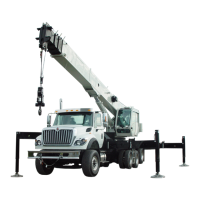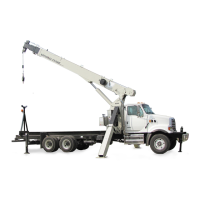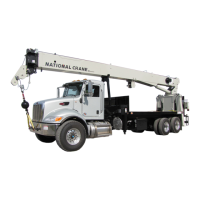National Crane 3-29-2018 Control # 610-00 3-15
NBT40-1 SERIES OPERATOR MANUAL SAFETY INFORMATION
PARKING AND SECURING
When parking on a grade, apply the parking brake and chock
the wheels.
These instructions are intended to allow the aerial lift to be
placed in the most stable and secure position. However,
National Crane recognizes that certain jobsite conditions
may not permit the boom and boom extension of equipment
to be fully lowered to the ground. When a qualified person at
a jobsite determines that it is not practical to lower the boom
to the ground, we recommend the following additional
instructions be followed:
• The aerial lift should be left in the smallest, most stable,
valid operational configuration that the job site
practically allows.
• The aerial lift can not be left running, in erection mode, or
in wind conditions in excess of allowed values.
• The boom should be retracted as far as is practical, the
aerial lift configured in as stable a configuration as
possible (boom angle, superstructure orientation, boom
extension angle, etc.)
• In high winds the boom and boom extensions should be
lowered, or secured. Changing weather conditions
including but not limited to: wind, ice accumulation,
precipitation, flooding, lightning, etc. should be
considered when determining the location and
configuration of a aerial lift when it is to be left
unattended.
SHUT-DOWN
Use the following steps when shutting down the aerial lift:
• Engage the parking brake.
• Fully retract and lower the boom.
• Remove and stow the aerial work platform.
• Engage the swing lock pin and/or 360 degree swing
lock.
• Place controls in neutral position.
• Stow the outriggers.
• Shut down the engine and remove the ignition key.
• Chock the wheels, if not on outriggers.
• Lock the operator’s cab (if applicable) and install vandal
guards, if used.
TRANSPORTING AERIAL LIFT
Before transporting the aerial lift, check the suitability of the
proposed route with regard to the aerial lift height, width,
length, and weight.
Check load limits of bridges on the travel route and ensure
they are greater than the combined weight of the aerial lift.
When loading or unloading the aerial lift on a trailer or
railroad car, use a ramp capable of supporting the weight of
the aerial lift.
Ensure the aerial lift is adequately secured to the
transporting vehicle.
Do not use the dead end lug on the boom nose for tying
down the boom during transport. Damage to the lug and
boom can result from usage as a tie down point.
Before transporting the aerial lift on a road or highway, first
check state and local restrictions and regulations.
TRAVEL OPERATION
When traveling, remove and stow the aerial work platform.
The boom should be completely retracted and lowered to the
travel position. If equipped with boom rest, lower the boom
into the boom rest and engage the turntable swing lock pin
and/or 360 degree swing lock (if equipped).
Traveling at high speeds, especially on rough ground, may
create a bouncing effect that can result in loss of control. If
bouncing occurs, reduce travel speed.
.Stunt driving and horse-play are strictly prohibited. Never
allow anyone to hitch a ride or get on or off moving aerial lift.
Follow the instructions in this manual when preparing the
aerial lift for travel.
If using a boom dolly/trailer, thoroughly read and understand
all the steps and safety precautions in this manual for setup
and travel.
When driving the aerial lift, ensure the cab is level, if
equipped with a tilting cab.
WARNING
Tipping Hazard!
When parking the aerial lift and leaving it unattended
follow the instructions for the Controls and Operating
Procedures of this manual.
Failure to comply with these instructions may cause death
or serious injury
WARNING
Crushing Hazard!
Death or serious injury could result from being crushed by
revolving tires.
Keep Clear of revolving tires.

